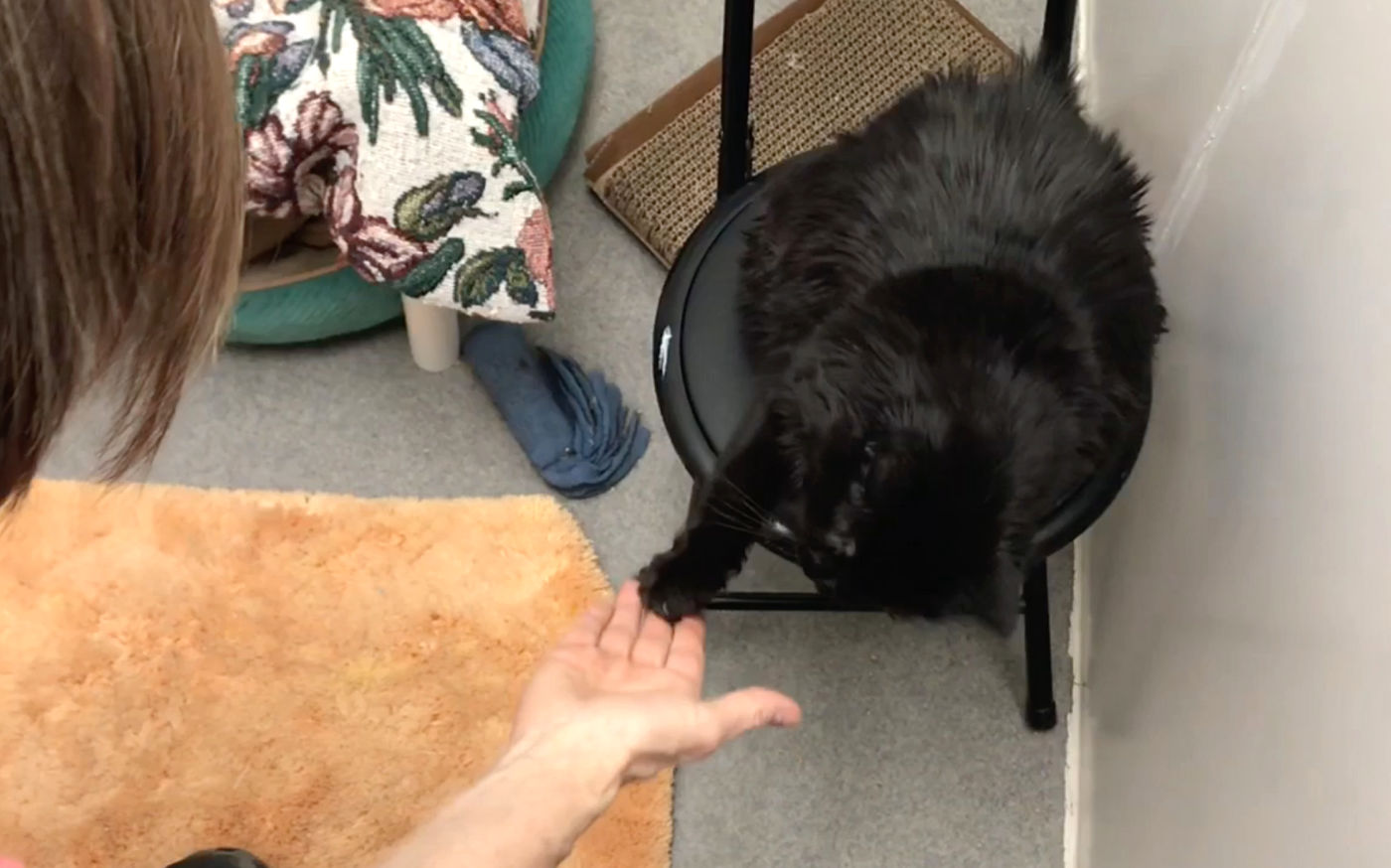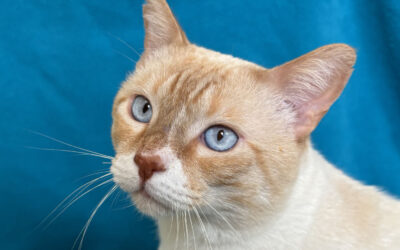You’ve learned a little about Clicker Training. Now you know the basics like the importance of the treat, which clicker to use, the Big Two Rules and how to get a behavior.
Here are some basic behaviors to get you started!
DON’T TEACH SIT YET
Animals tend to defualt to their first learned behavior. Cats are hardwired to sit very still while hunting, so if you teach a Sit, you’ll have a cat who thinks you’re rewarding it for not moving. This can get in the way of other learning.
CHARGE THE CLICKER
This means pairing the click with a treat in the cat’s mind. Feed the cat the treat 8-10 times while clicking right after the cat starts to eat (Click/Treat or C/T). Very soon the cat will start to anticipate the wonderful thing that’s about to happen when you click.
Teaching a moving behavior, like Target or Come, will get your kitty engaged.

TARGET Find a small stick, like a long chopstick or end of a cat wand (buy a dollar store wand toy and cut off the string & toy). Place the stick in front of the cat. Most adults will naturally lean to sniff the stick.
The instant you have nose to stick contact, click. Try to treat within 2 seconds or less. If you hold the clicker and a few treats in the same hand, you’ll be less apt to intimidate some cats with a click in the ear. You don’t want the click to be a scary thing.
Some cats, especially kittens, may want to play with the stick using their paws. Avoid rewarding when that happens. Wait for the nose to touch the stick instead. The pawing should fade if not rewarded, while the nose touches will increase.
Target is especially useful for getting cats to move where you want them to go of their own choice. Anyone who’s ever tried to force a cat to go somewhere it doesn’t want to will appreciate this.
You can play Herd the Kitty with Target. Simply move around your room, tapping different surfaces and rewarding your cat for jumping up to touch the stick.
COME Some people tell us their cat doesn’t know his or her name. If that’s the case, it’s because you haven’t taught it to them! Pairing it with a reward will quickly teach the behavior.
This skill is especially useful in situations like if your cat gets outside or if you need to evacuate for a fire or other emergency.
Starting from a foot or so away from your cat, say the cat’s name and get his or her attention by patting the floor or your leg (NOT by clicking, as that ruins the power of the click to mark the behavior).
When your cat turns toward you, C/T. Repeat this until your cat is coming directly in front of you, clicking exactly when that happens.
Then you can move a little further away and repeat. Your cat should quickly learn that his or her name means something wonderful will happen next.
THE COME GAME
You can turn this into The Come Game by getting a partner who also has treats. Set the cat in between you and take turns saying his or her name, rewarding when the cat gets right in front of either of you. Gradually add distance and you will have a cat trained to come to his or her name whenever they hear it!
SIT
Once you have movement behaviors trained, you can teach Sit. Sit is the precursor to training a Sit Pretty, High Five and other more flashy behaviors.
Your cat should now know that when you get out the treats, fun things will follow, and will likely be following you around. If you stand still, the cat should naturally sit down to wait for you to do something interesting.
Be watchful…the second the cat’s rear is flat on the ground, C/T. It’s helpful if you can toss the treat slightly away from where the cat sat so it has to get out of position to get the treat. You can then repeat this, moving around the room.
Make sure the cat’s rear is flat on the ground. If you click when it is partway down, you could end up with a squatting cat!
Once your cat is reliably doing a Sit 80% of the time, you can add a verbal and/or visual cue. As your cat is sitting, say “Sit!” instead of clicking, and then treat.

SIT PRETTY
Once your cat has learned Sit and Target, it’s easy to teach a Sit Pretty.
Reward your cat for a Sit so she’s in position. Raise your Target stick over the cat’s head. Watch carefully! The second the cat rises up even a bit, C/T. Do this a few times until the cat is reliably rising up. This is using the stick as a Lure to get the behavior started.
Then wait without using the Target stick. If you’re patient and the cat has been rewarded enough for rising up, he or she will probably do it on their own. Immediately C/T when they do.
Don’t worry if the cat is only lifting partway at first. If you keep rewarding but raising the criteria by waiting just a bit each time until the cat rises up just a little more, eventually he or she will come to a full Sit Pretty. This is known as Shaping the Sit Pretty.
Continue to C/T until you get that 80% completion. Then you can add the command and/or hand signal to cue the behavior.

HIGH FIVE
This also starts from a Sit. Reward your cat for a Sit so he’s in position.
Decide what your hand position will be. Is it palm forward so your cat touches your fingertips? Is it palm up so your cat slaps your palm? Is it a fist bump? Once you choose, be consistent. That hand position can become the cue for the behavior.
Place your hand in front of the cat. Many cats will naturally reach out. Immediately C/T if you get any sort of reaching out, even if it’s just lifting one paw slightly. Shape the behavior by rewarding but raising the criteria each time by waiting just a bit until the cat reaches out further. Eventually, he or she will touch your hand.
If you use the same hand position every time, you will have already cued the behavior. You can add a verbal cue once you hit 80%, like “High five!” or “Gimme some skin!”

GO TO MAT Pick a small flat mat like a large trivet, mouse pad or washcloth. Make sure it’s something you like because you’ll likely be using this for a long time.
Place the mat in front of the cat. Wait for the cat to step on the mat by itself. If he or she shows little interest, walk around with the mat between you and the cat, calling its name, and watch for that first step on the mat. The second the paw touches the mat, click then feed the treat a little away from the mat.
You want the cat to choose to go to the mat, so don’t feed it on the mat at first. When the cat is reliably touching the mat, up the ante: don’t C/T until the cat touches with 2 feet, then C/T for a few times. When that’s reliable, again up the ante: don’t C/T until you get 3 feet, then 4. This is Shaping your Go to Mat.
If your ultimate goal is for the cat to sit on the mat, reward him or her on it once that’s accomplished. Then use your Target stick to reward for moving away. When he chooses to go sit on the mat, reward again. Keep repeating this until he’s choosing to go sit on the mat 80% of the time. When he’s doing that, start adding a verbal command (“Go to mat!” or just “Mat!”) as he’s sitting on the mat.
If your ultimate goal is for the cat to lie down on the mat, you can either shape small steps toward a Down (like you did, above) or wait until he gets bored enough to lie down. The second he does, C/T.
End the session by saying “Release!”, slipping the mat from under the cat and giving a final treat. Put the mat away until next time.
You’ve just learned how to both Capture and Shape other behaviors. Both these behaviors are the foundation for many more. Grab yourself a book on Clicker Training cats and let the games begin!
Here are more helpful how-tos:
Clicker Play for Cats




